Running Oracle Database Server as a Docker container

At work, I had to create an Oracle Enterprise database locally so that I could code scripts in different languages to show how to connect to Oracle using, for example .Net, NodeJS, Python or PHP.
So the idea was immediately to check whether there was an official image for this. And there is one but, damned, it's not as simple as for PostgreSQL, MySQL, MS SQL Server.
In this article, which is a clean-up of my notes, we're going to install Oracle Enterprise locally in a container, create a database with example data and access the database in several ways.
It's a step-by-step guide to make life easier for anyone who needs to do the same thing - me, for example, in a few months' time when I've forgotten everything.
Download a Docker image for OracleDB
So, yes, there is a Docker image called container-registry.oracle.com/database/enterprise:latest but before being able to download it, we'll need to do a few things:
- Create a free account on oracle.com,
- Generate a token,
- Accept License terms,
- Configure your local Docker environment to use that token.
If you miss one step and try to download the image immediately, you'll get this error:
> docker pull container-registry.oracle.com/database/enterprise:latest
Error response from daemon: Head "https://container-registry.oracle.com/v2/database/enterprise/manifests/21.3.0.0": unauthorized: Auth failed.
Creation of a free account on oracle.com
Please surf on https://container-registry.oracle.com/ords/ocr/ba/database/enterprise and create a user by clicking on the Sign In button / top right link.

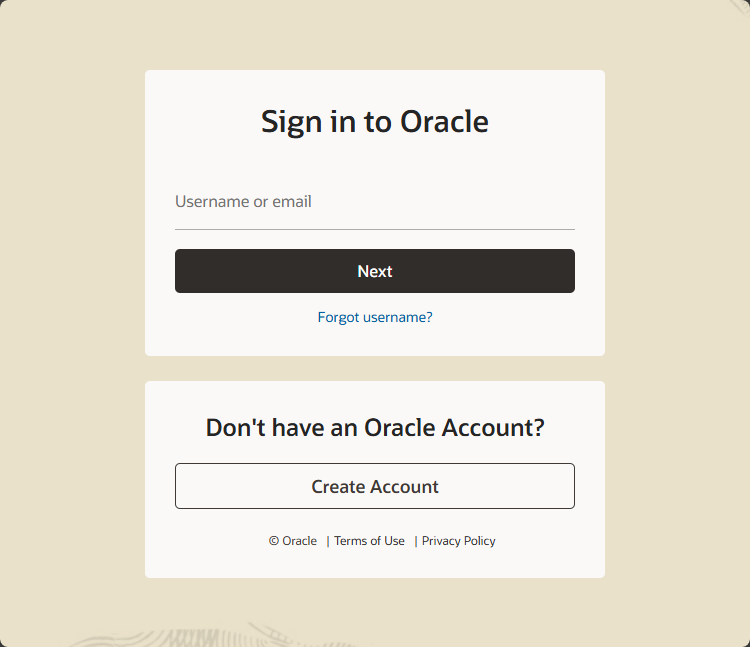
Generate a token
Once your user has been validated (after reception of an email); go back to the https://container-registry.oracle.com/ords/ocr/ba/database/enterprise website; do a login and click on your profile then choice Auth Token.
Click on the Generate Secret Key button and copy your SSO Username and your Secret Key somewhere (in your password vault application f.i.).
Accept License terms
Please go to https://container-registry.oracle.com/ords/ocr/ba/database and search for enterprise in the Repository column.
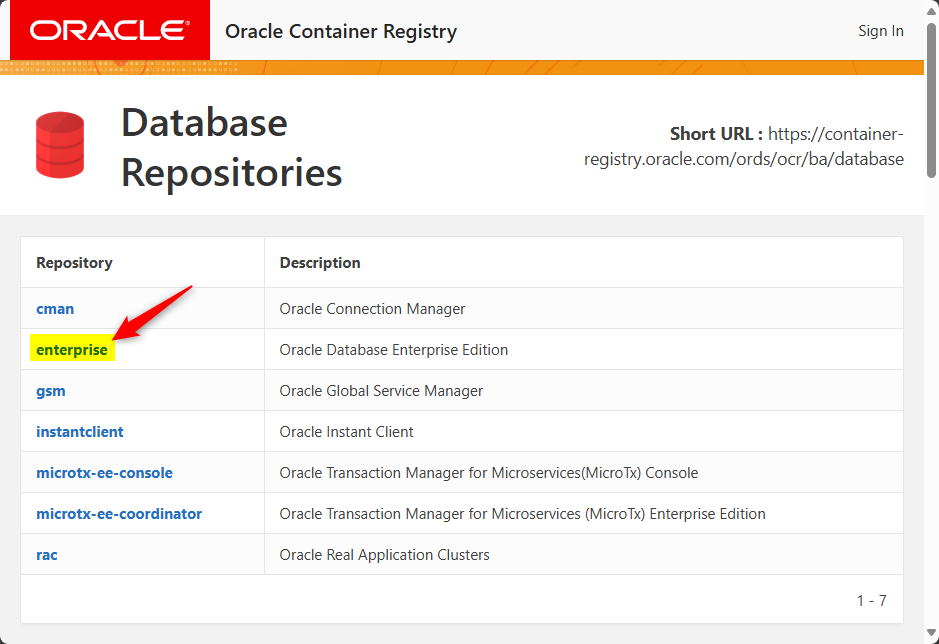
Being logged in, please click on the Continue button that appears on the right.
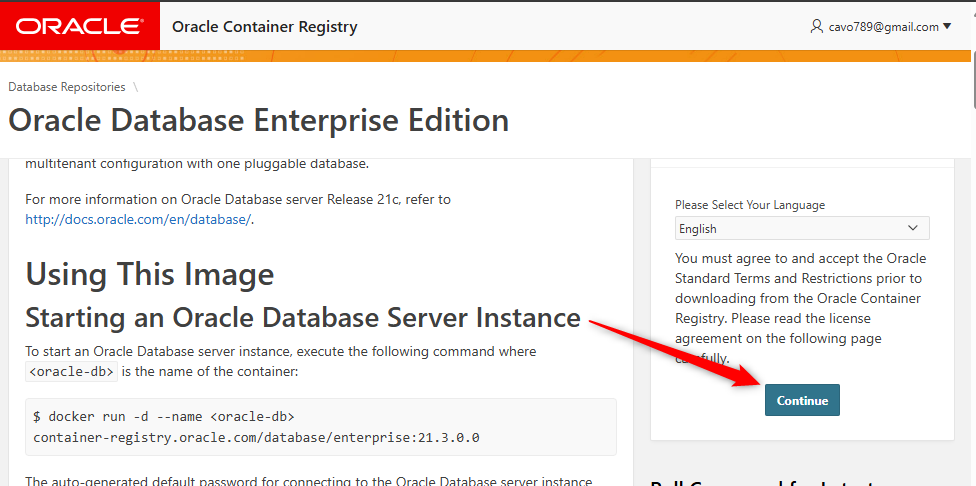
A popup window will be displayed and, at the bottom, you'll need to click on Accept.
Optional, by going back to https://container-registry.oracle.com/ords/ocr/ba/database you'll see that Oracle has recorded the fact you've accepted their terms.
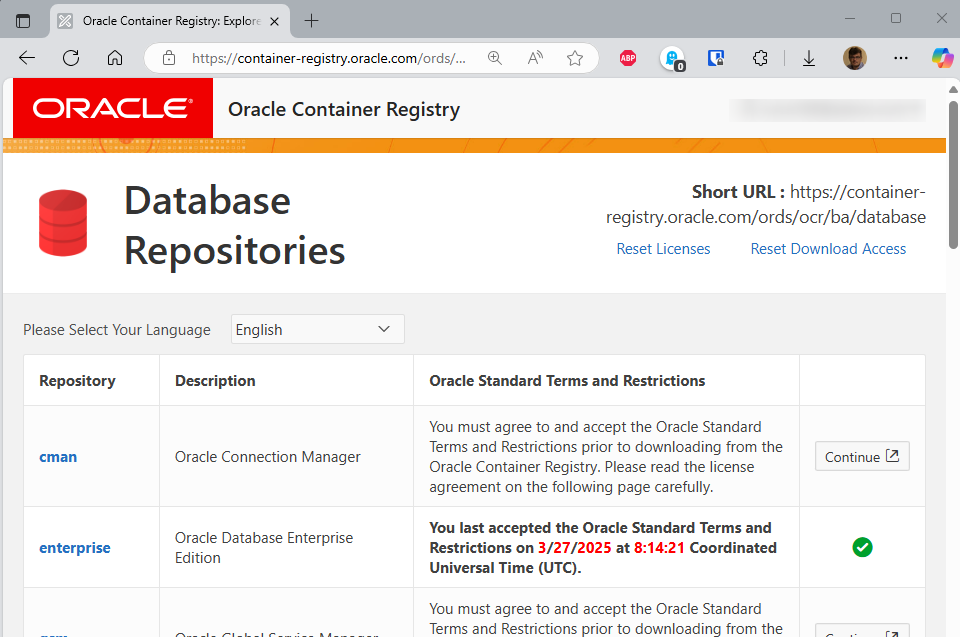
Configure your local Docker environment
Last part, teach Docker you can download from the Oracle registry.
Go to the command line and type docker login container-registry.oracle.com.
Fill in your SSO Username and your Secret Key (as given by the Auth Token page on oracle.com).
Docker will display Login Succeeded.
If needed, run docker logout container-registry.oracle.com to remove the authentication to oracle.com on your computer.
By running cat ~/.docker/config.json, you'll see in auths the presence of the Oracle registry
{
"auths": {
"container-registry.oracle.com": {},
"https://index.docker.io/v1/": {}
},
}
Finally, you can pull the image
If all previous steps have been correctly done, now, you should be able to run docker pull container-registry.oracle.com/database/enterprise:latest without any error and download the 3.5GB Docker image.
There is a slim image around 1.5GB (docker pull container-registry.oracle.com/database/enterprise:12.2.0.1-slim) but it's a very old one (somewhere in 2018).
Important concepts to consider when working with Oracle v12 and after
Container database (CDB) versus Pluggable database (PDB)
In Oracle's multi-tenant architecture (introduced since Oracle 12c), the concepts of Container Database (CDB) and Pluggable Database (PDB) are fundamental.
In comparison with other database engines, a PDB is a database while the CDB is the underlying container infrastructure that manages one or more PDBs, sharing common background processes and memory.
In this article, we're only interested to create tables in a database (PDB) we always need to make sure to connect to a PDB like when creating tables. We want that our tables are in a single database; not "shared" at CBD root level.
So, every time we'll need to work on tables; make sure to connect to the PDB.
Create an Oracle database container
Once the image has been pulled, we can create our container i.e. our Oracle database service.
The list of supported command line flags is here: https://container-registry.oracle.com/ords/ocr/ba/database/enterprise#custom-configurations
If we wish, we can run a docker run command right now but, before, let's make some configuration.
Why? Because the container generation is terribly slow and can take up to ten minutes.
In order to be as efficient as possible, we'll first create a set of files on our disk so while creating the database, Docker will also automatically create some tables and put records in them.
Creation of some configuration files
Please create a new folder on your disk and jump in it: mkdir -p /tmp/oracle && cd $_.
Please also run this statement to create the folder where we'll put our startup files: mkdir -p scripts/startup.
Let's create a Human Resources sample database
Oracle provides some sample databases on the Oracle Database Sample Schemas page. You can download from there the db-sample-schemas-23.3.zip archive, open it and go to the human_resources folder. You'll found there a file called hr_create.sql which is a sample of an HR database. There is a second file called hr_populate.sql to feed the tables with some data.
For easiness, you can retrieve these files by clicking on these two links: hr_create.sql and hr_populate.sql.
Please download and copy these two files in the scripts/startup/sql/ folder you've previously created.
The second thing to do is to create the file scripts/startup/populate_db.sh with the content below so we'll automate the creation of our tables and put some records in our database. As said in a previous chapter, it's important to make sure to connect to the PDB so tables are created in a database; not in the container.
scripts/startup/populate_db.sh
#!/usr/bin/env bash
sqlplus -S sys/admin@localhost:1521/ORCLCDB AS SYSDBA <<EOF
ALTER SESSION SET CONTAINER = ORCLPDB1;
CONNECT system/admin@orclpdb1
@/docker-entrypoint-initdb.d/startup/sql/hr_create.sql
@/docker-entrypoint-initdb.d/startup/sql/hr_populate.sql
COMMIT;
EXIT;
EOF
Now, make the script executable: chmod +x scripts/startup/populate_db.sh.
Pay attention to the CONNECT system/admin@orclpdb1 statement: we'll first connect as the system user before creating the tables. So, tables will be accessible by that user i.e. the system user.
If you need the data model, here it is:
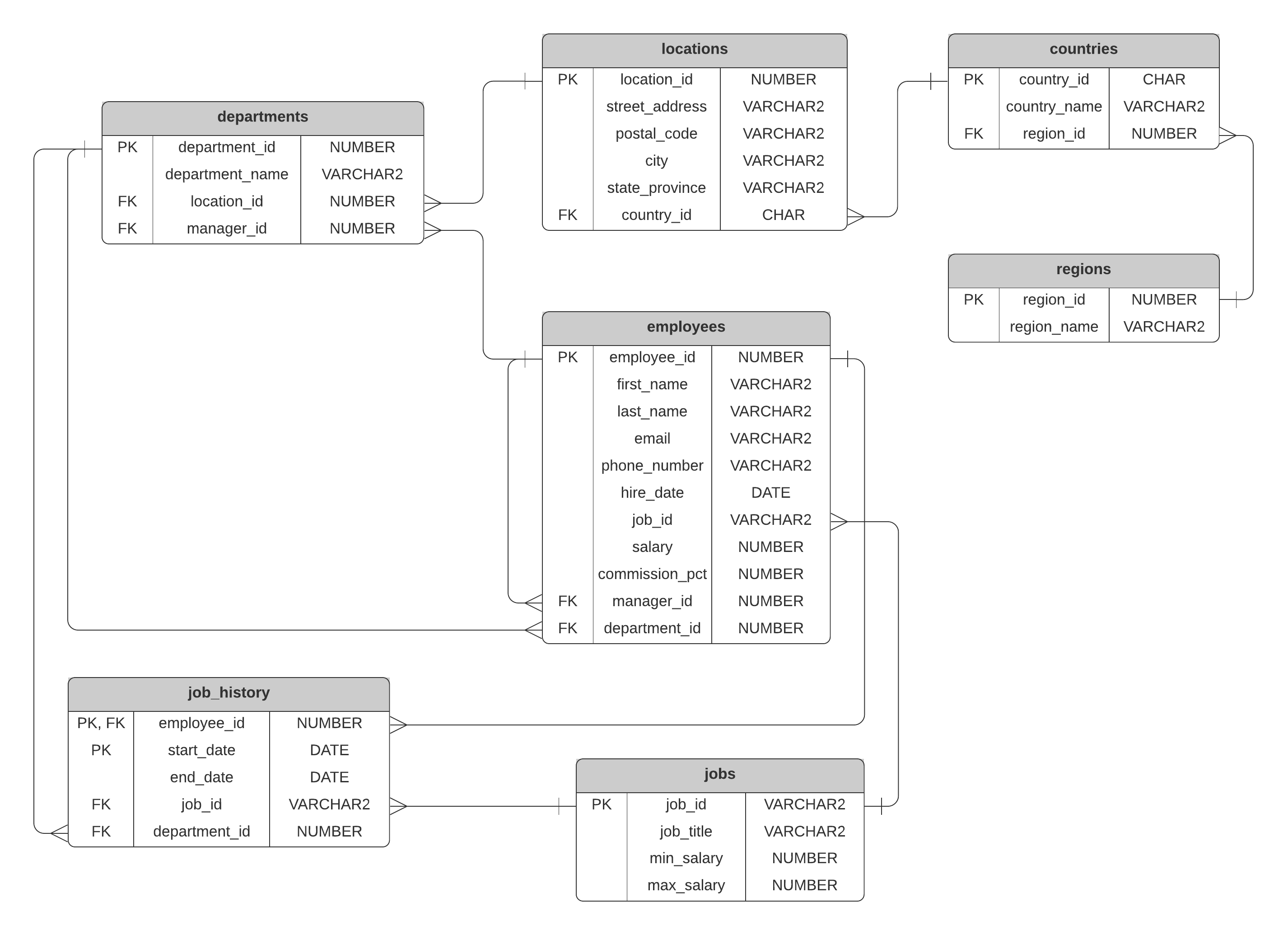
Create the OracleDBData volume
Because running the container is a very slow process, we'll create a Docker volume to keep the database persistent on the disk.
The volume will keep the database on our disk, in a Docker self-managed volume. Like this, we can stop the Oracle container, start it again and we'll not lose our database. The DB will be persistent into a self-manager Docker volume.
Please run docker volume create OracleDBData in the console to create a Docker self-managed volume.
Create the oracle network
And lastly, we'll create a specific network for our Oracle container: docker network create oracle.
Ready to create the container
We're ready to create our container by running this command:
docker run -d \
--name oracle-db \
--network oracle \
-p 1521:1521 \
-p 5500:5500 \
-e ORACLE_SID=ORCLCDB \
-e ORACLE_PDB=ORCLPDB1 \
-e ORACLE_PWD=admin \
-v OracleDBData:/opt/oracle/oradata \
-v ./scripts/startup/:/docker-entrypoint-initdb.d/startup \
container-registry.oracle.com/database/enterprise:latest
This is terribly slow... Oracle will need something like 10 minutes before the container can be used.
The docker run was terribly complex; here is a breakdown:
--name oracle-db: Our running container will be namedoracle_db(so we can access to it later on by runningdocker exec -it oracle-db [...]),--network oracle: We will create our container on theoraclenetwork,-p 1521:1521: Oracle use a port number 1521 (Oracle Listener) and we'll expose that port on our machine,-p 5500:5500: Optional. Oracle use a second port number 5550 (OEM Express) and we'll expose that port too so we'll be able to access tohttp://localhost:5500,-e ORACLE_SID=ORCLCDB: The Oracle Database SID (SID stands for System identifier) is a very important setting. We'll keep the default value which isORCLCDB(remember;CDBstands forContainer database)-e ORACLE_PDB=ORCLPDB1: The Oracle Database PDB name. Here too, we'll keep the default value which isORCLPDB1. (remember;PDBstands forpluggable database).-e ORACLE_PWD=admin: The Oracle database SYS, SYSTEM and PDBADMIN password. There is no default value since the password is auto generated and should be retrieved from the logs (docker log). This parameter modifies the password for the SYS, SYSTEM and PDBADMIN users.-v OracleDBData:/opt/oracle/oradata: We'll persist the database on our disk but we don't care where, we'll let Docker to manage it. We've previously created a Docker volume namedOracleDBData.-v ./scripts/startup/:/docker-entrypoint-initdb.d/startup: This will allow to create files locally in the./scripts/startupfolder (like our SQL files) and run them inside the container once the main Oracle database is ready. And, indeed, we've created previously the scriptpopulate_db.sh,sql/hr_create.sqlandsql/hr_populate.sqlfiles in ourscripts/startupfolder.
Important constants to remember
From now on, our Oracle database server is running as a Docker container. We'll use some constants a lot.
Here are the constants to remember:
1512is the port number to use when connecting to the Oracle DB service,oracle-dbis the name of our container,ORCLCDBis the name of our CDB,ORCLPDB1is the name of our pluggable database,adminis the password to use andsystemis the user used when we've created the database
If you look back at the populate_db.sh script, we had:
sqlplus -S sys/admin@localhost:1521/ORCLCDB AS SYSDBA <<EOF
ALTER SESSION SET CONTAINER = ORCLPDB1;
CONNECT system/admin@orclpdb1
@/docker-entrypoint-initdb.d/startup/sql/hr_create.sql
@/docker-entrypoint-initdb.d/startup/sql/hr_populate.sql
COMMIT;
EXIT;
EOF
And now, you understand why connection strings were:
sys/admin@localhost:1521/ORCLCDB:sysis a system user in Oracle,adminthe associated password,1521our exposed port andORCLCDBis the name of our container database,ALTER SESSION SET CONTAINER = ORCLPDB1;: we need to create our tables and our records in our database (ORCLPDB1) andCONNECT system/admin@orclpdb1:systemis also a system user in Oracle, it'll be the owner of our tables,adminis the same, associated password andorclpdb1is the name of what Oracle call theservice.
Running an interactive console in the DB container
If you need to jump in the container, simply run docker exec -it oracle-db bash.
As a fictive example, we can go to the /docker-entrypoint-initdb.d/startup folder inside the container and run our ./populate_db.sh script again (again because was fired by Oracle during the creation of the container):

And of course, we'll get a lot of errors illustrating the fact that tables and records were already created/inserted.
Type exit to quit the console and go back to your host prompt.
Working with the Oracle DB container
So the docker run command will take something like 10 minutes to run.
If you've Docker Desktop, switch to its interface, click on the Containers link and click on your oracle-db container to see the log. Wait until you see:
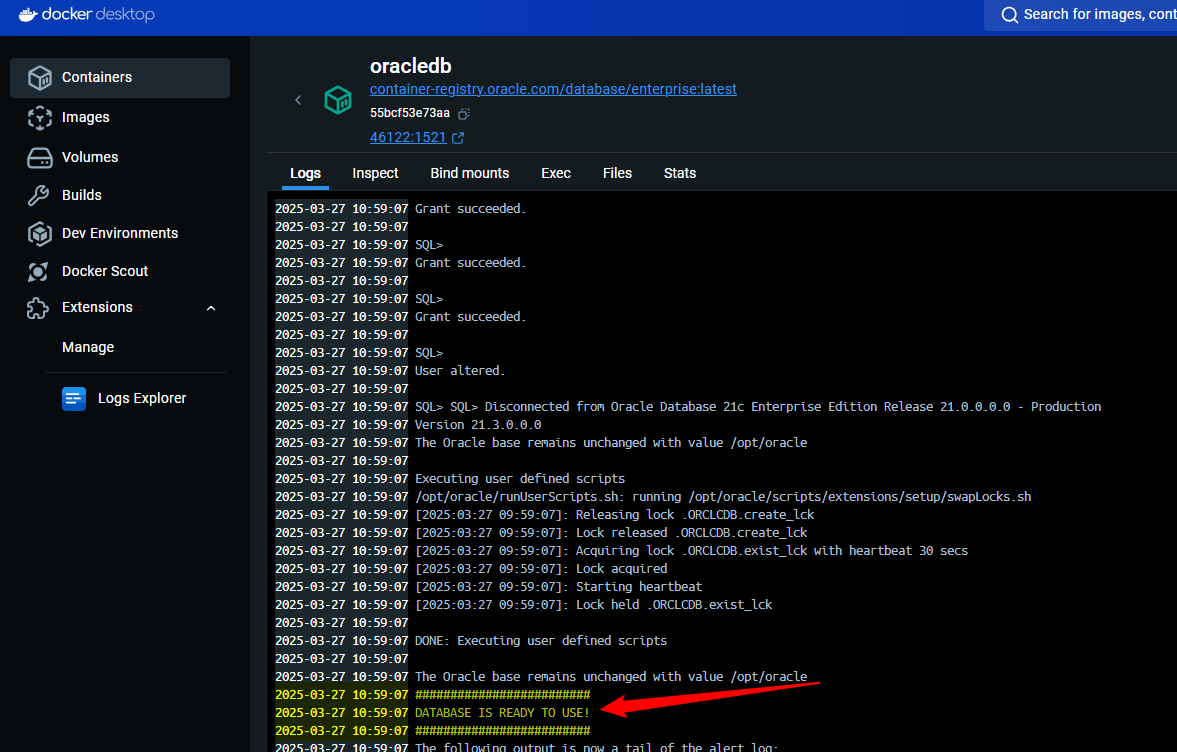
You can also use the command line: docker logs oracle-db --follow and wait until we see the DATABASE IS READY TO USE! message. Press CTRL+C to quit the log.
Now, we can jump in the oracle-db container and run SQL*Plus by running docker exec -it oracle-db sqlplus sys/admin@ORCLPDB1 as sysdba (remember: we'll connect to the PDB; not the CDB).
Just run, in the SQL*Plus console, the SHOW CON_NAME; command.

If you're connected to the CDB, you'll get the next answer and it's wrong. Type exit and connect to the PDB.
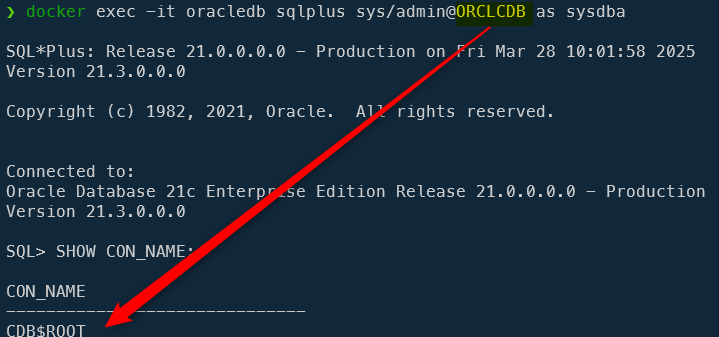
A word about schema
Previously, we've created our tables using the scripts/startup/populate_db.sh script. Here was the script used:
#!/usr/bin/env bash
sqlplus -S sys/admin@localhost:1521/ORCLCDB AS SYSDBA <<EOF
ALTER SESSION SET CONTAINER = ORCLPDB1;
CONNECT system/admin@orclpdb1
@/docker-entrypoint-initdb.d/startup/sql/hr_create.sql
@/docker-entrypoint-initdb.d/startup/sql/hr_populate.sql
COMMIT;
EXIT;
EOF
The CONNECT statement will use the system Oracle user. Tables that will be created in the system schema.
If we run docker exec -it oracle-db sqlplus sys/admin@ORCLPDB1 as sysdba and try to display records of the COUNTRIES table; it will not work unless we specify the schema:
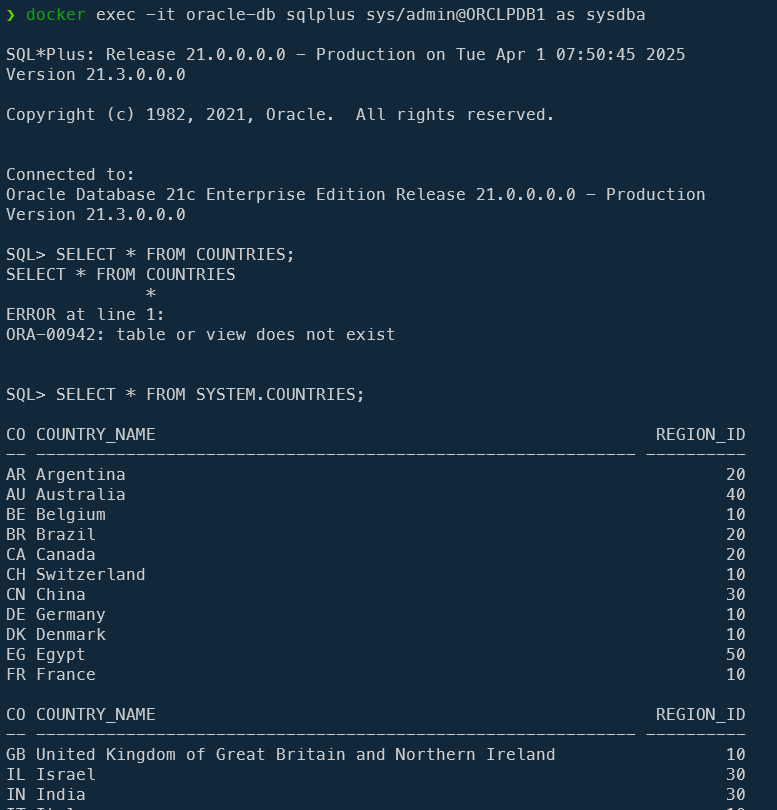
This is because the sys user use the sys schema by default (we can see this by running SELECT SYS_CONTEXT('USERENV', 'CURRENT_SCHEMA') FROM dual;).
This is why, because our tables are in the system schema; we can access to them by running SELECT * FROM SYSTEM.COUNTRIES;.
But, we can also change our user, no more using sys but system by running CONNECT system/admin@orclpdb1.
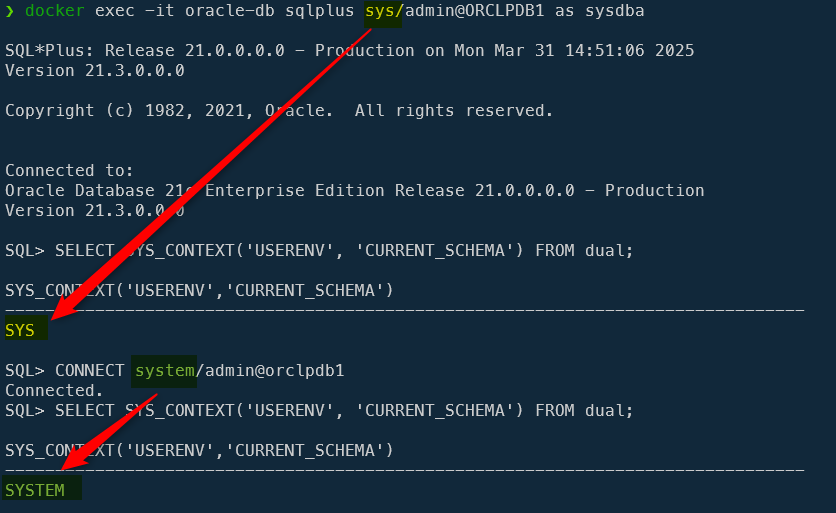
Check our fake data
This understood, here is how we can see our data:
- Run
docker exec -it oracle-db sqlplus sys/admin@ORCLPDB1 as sysdba, - Then, in SQL*Plus, run
CONNECT system/admin@orclpdb1, - For esthetic purposes, we'll run
SET WRAP OFFandSET PAGESIZE 1000and - we can access to our tables like this:
SELECT EMPLOYEE_ID, FIRST_NAME, LAST_NAME, EMAIL FROM EMPLOYEES;
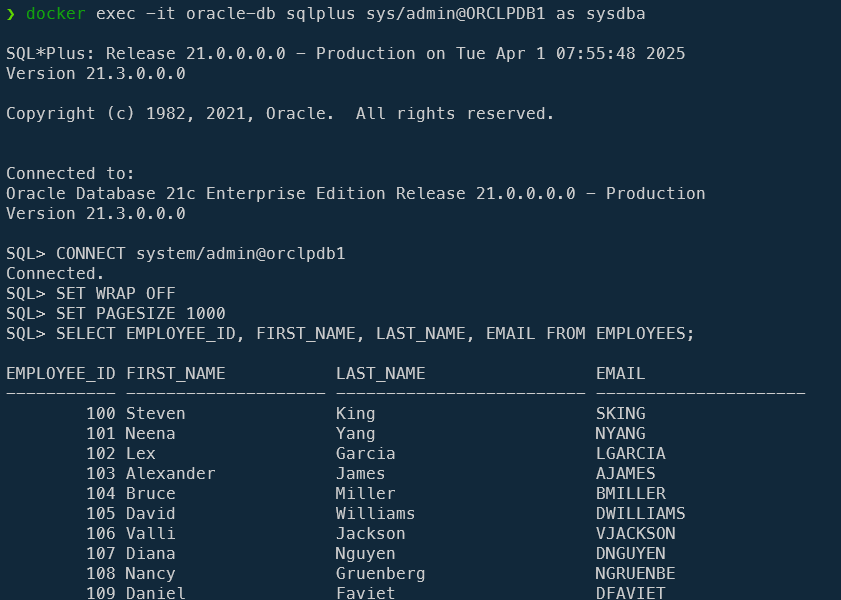
SET WRAP OFF will allow to use the screen full width and not a ridiculous width of 80 characters and SET PAGESIZE 1000 is to not have a paginated list every 10 records.
Accessing to the Oracle Enterprise Manager Database Express
Earlier, when running our docker run command, we've mapped the port 5500 from the container on our host. That port is the one used by Oracle Enterprise Manager Database Express (aka OEM Express).
This is a web application we can reach by surfing to https://localhost:5500/em/.
Connect to it using system / admin and orclpdb1 as container name.
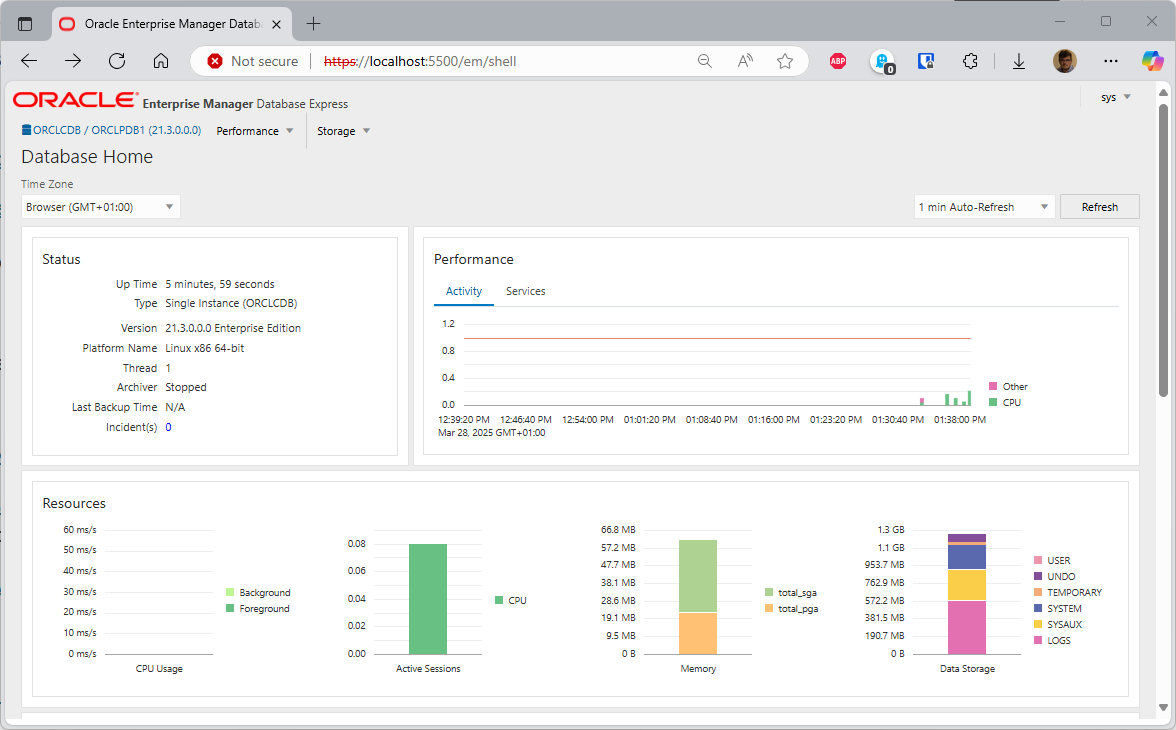
Accessing our database using Oracle tools
Oracle SQL Developer
You can download Oracle SQL Developer. It's a ZIP file and once unzipped; you can run the interface without the need to install the software, it's ready-to-use.
Once installed, run it and create a new connection to:
- Username:
SYS, - Role:
SYSDBA, - Password:
admin - Hostname:
127.0.0.1, - Port:
1521and - Service name:
orclpdb1

Tables are located in the pluggable database (PDB); not in the container database (CDB)
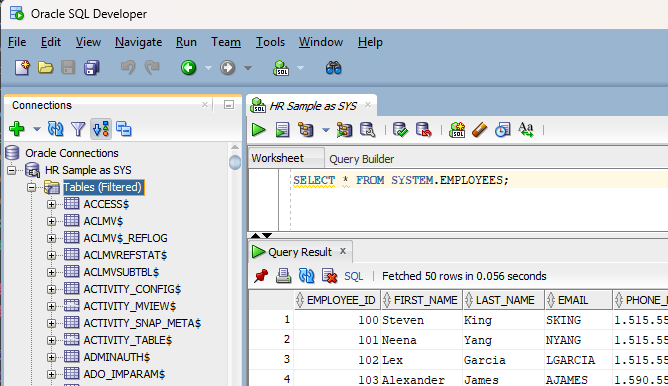
Start to type SELECT * FROM system. and press CTRL+SPACE to get the list of objects in that schema. By scrolling a few, you'll find employees.
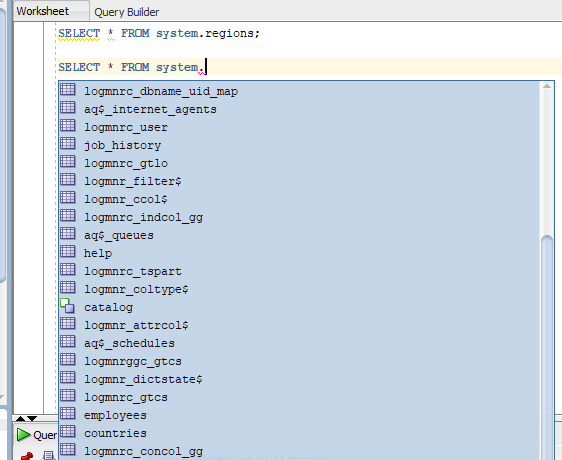
Validate or simply type the full SQL SELECT * FROM system.employees. In the example below, I'll ask the list of regions and the list of employees. I will run the query by simply pressing
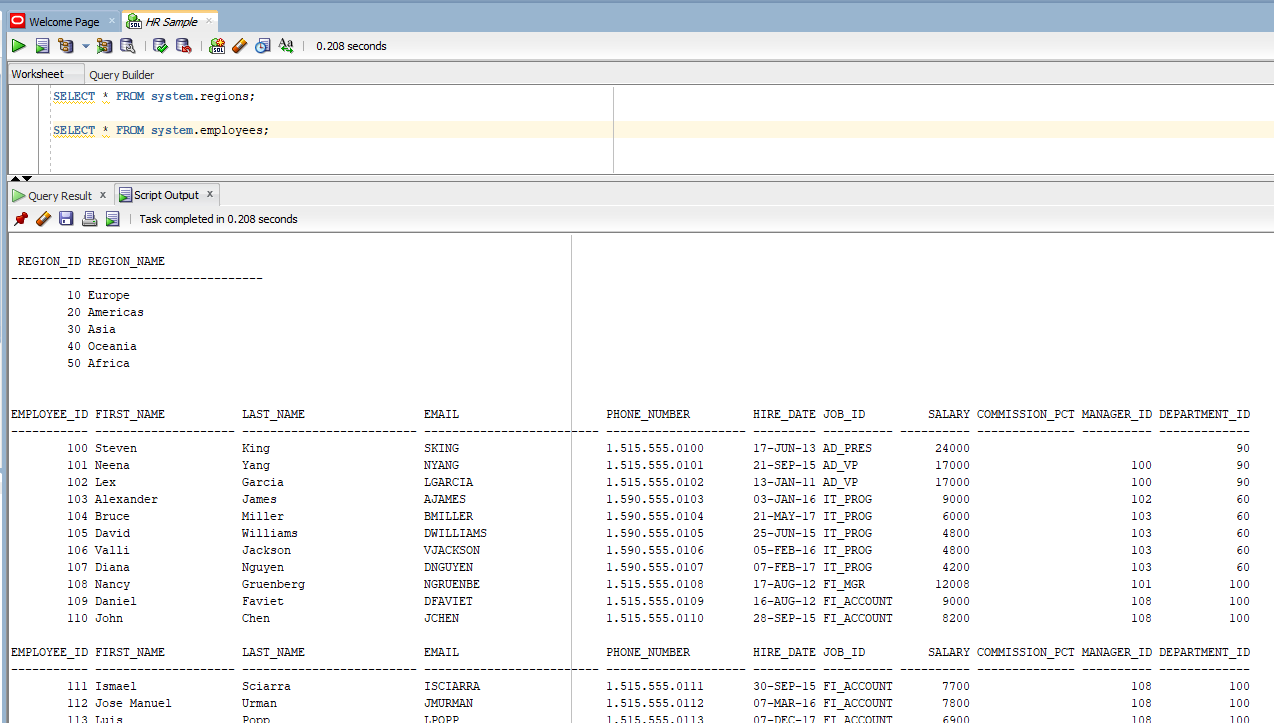
Connect to Oracle SQL Developer using the correct user
In the previous chapter, we've established a login using sys for the username and for that reason, if we click in the Tables (Filtered) menu in the left tree view, we'll get a bunch of tables but not the one of the system user like our employees table.
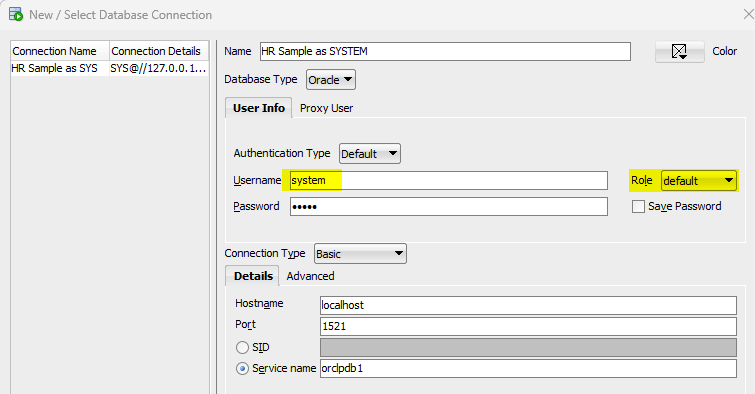
Now, by unfolding the list of tables, we can see ours:
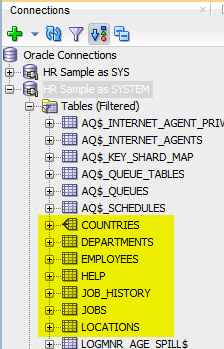
Access our Oracle DB container using Oracle SQLPlus
Another way would be to use the official sql*plus Docker image like this:
docker run --rm -it --network oracle oracletools/sqlplus:v19.18_lin SYS/admin@oracle-db:1521/orclpdb1 as sysdba
Once connected, for instance, we can get the list of countries like this:
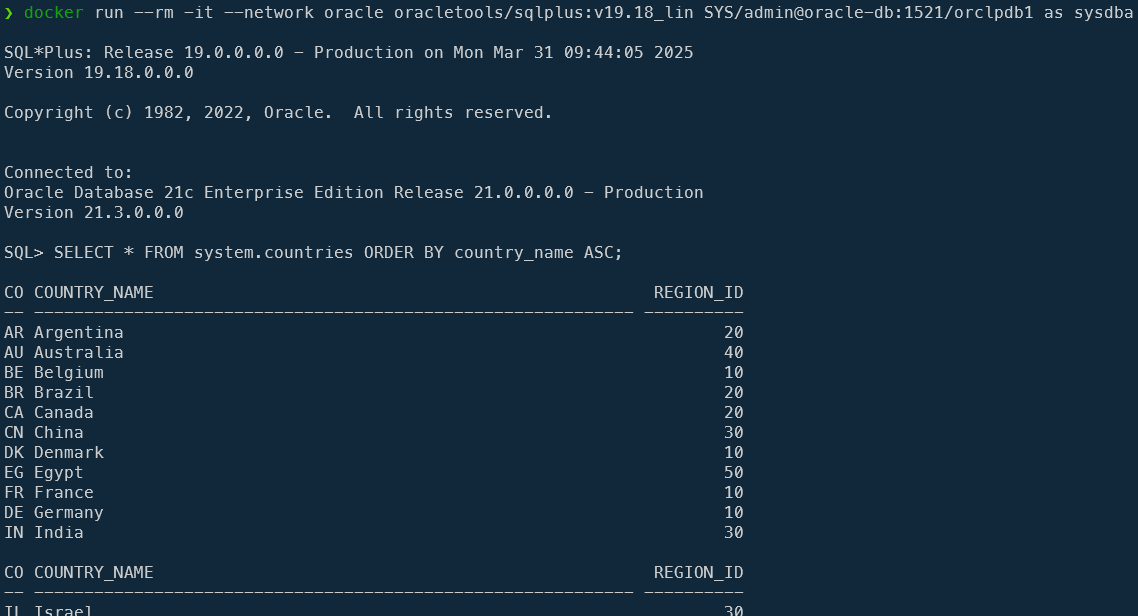
For this article, it was not really needed to use that image. Until now, we've more than once used SQL*Plus like when we've fired docker exec -it oracle-db sqlplus sys/admin@ORCLPDB1 as sysdba to connect to the database.
The difference is: docker exec -it oracle-db [...] jump in our database container and run sqlplus internally (from within the container where the database is stored) while docker run [...] oracle oracletools/sqlplus:v19.18_lin [...] run sqlplus outside as a separate container.